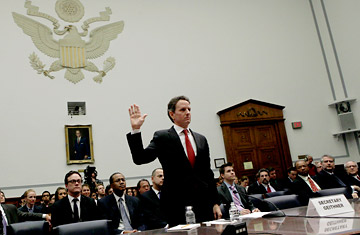
Treasury Secretary Timothy Geithner is sworn in prior to testifying before the House Oversight and Government Reform Committee on Jan. 27, 2010
AIG could have cut a deal and perhaps saved taxpayers billions of dollars.
According to a report produced by a division of bond manager BlackRock in November 2008, AIG would probably have been able to strike settlements that, at least at the time, could have saved the giant troubled insurer, and taxpayers, billions of dollars. Instead, after a few days of harried discussions, the Federal Reserve Bank of New York — which was orchestrating the government's bailout of AIG — instructed the insurer to pay its counterparties, which included Goldman Sachs and a number of European banks, in full. The BlackRock report is one of many documents recently unearthed by a congressional investigation into the controversial bailout of AIG, which could still cost taxpayers as much as $180 billion.
It's not certain that any of the banks would, at the end of the day, have gone along with any offers from BlackRock, an adviser to the Fed. Nor is it clear whether any deals would have been more profitable for AIG, given the rebound in the credit markets. But what is clear is that the troubled insurer had more room to bargain than it and its government rescuers have let on. AIG and BlackRock declined to comment both on the bond manager's report and AIG's bond-insurance dealings.
The AIG bailout has become one of the most enduring controversies from the financial crisis. On Wednesday, a congressional hearing again probed the moves and possible mistakes the government made when it rescued the insurer. At the center of the hearing, which was held by the House Committee on Oversight and Government Reform, were the payments that AIG made to banks that bought credit-default-swap (CDS) bond insurance from the firm. Members of the panel grilled Treasury Secretary Timothy Geithner, head of the Federal Reserve Bank of New York in late 2008, as to why he allowed AIG to pay the banks the starting value of the CDS contracts when the bonds had fallen significantly in price. Other mortgage-bond insurers at the time were able to strike deals to tear up similar contracts and pay reduced prices. Some called the AIG payments, funded by the government, a backdoor bailout of Wall Street, in particular Goldman Sachs. Also at issue were the moves the Federal Reserve made to cover up the fact that AIG had paid out the contracts at par, which was the contract's full original amount. "Why shouldn't we ask for your resignation as Secretary of Treasury?" said John Mica, a Republican Representative from Florida.
Geithner replied that he believes that the way he and the Fed devised to get AIG out of its CDS contracts will prove to be the least costly for taxpayers. He said he had no role in hiding facts about what AIG had paid its counterparties or who those counterparties were. Former Treasury Secretary Henry Paulson, who also testified at the hearing, said he was broadly supportive of the AIG bailout but had no knowledge of any payments that AIG made to particular banks.
"If we had tried to force counterparties to take less than they were entitled, AIG would have collapsed," Geithner told the congressional committee. "There were no better alternatives."
Back in late 2008, though, even at the height of the financial crisis, BlackRock believed AIG could have struck deals with the big banks that would have saved the company money. At issue were the credit-default swaps — essentially bond insurance that would pay out if borrowers didn't — that AIG had sold to a number of large banks and financial firms. Lawyers say there would have been nothing legally wrong with AIG's negotiating to pay some banks less than others on the CDS insurance they had bought from AIG. In fact, since the CDS contracts insured different bonds, it would have been normal for those insurance contracts to be settled at different prices.
